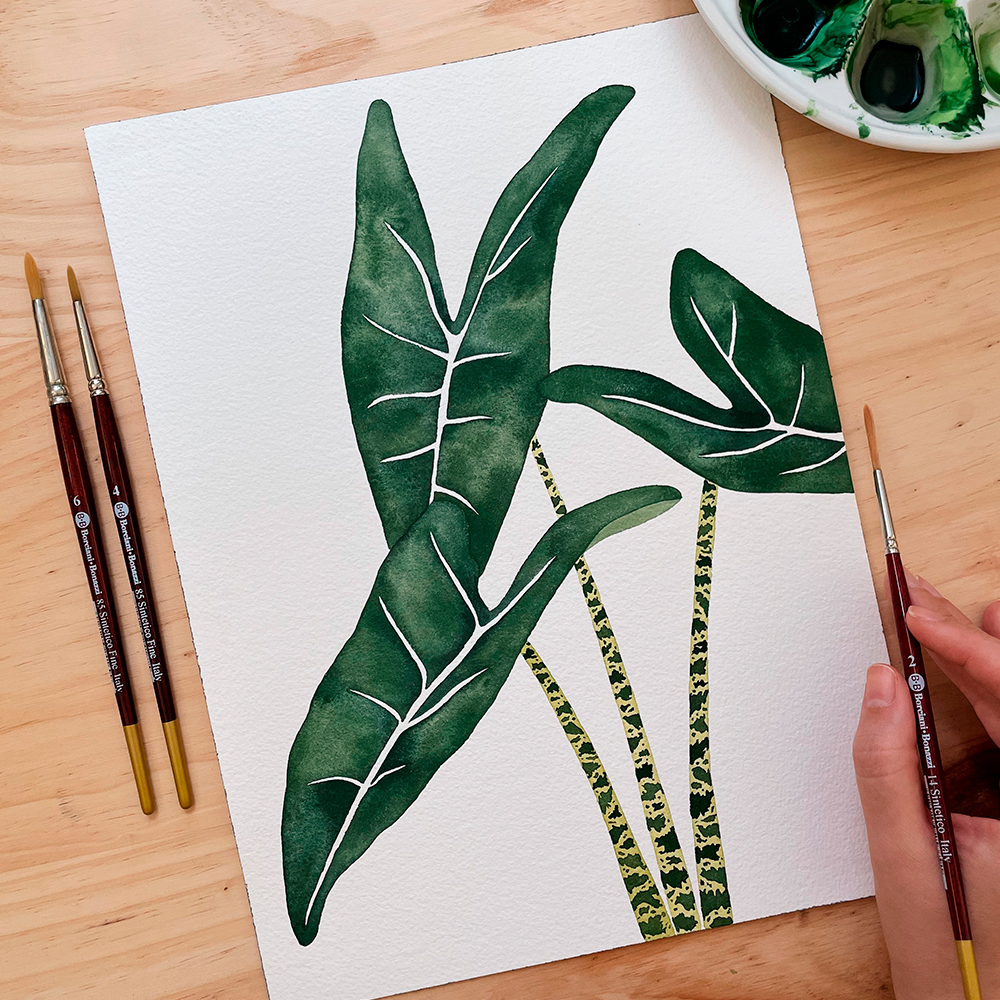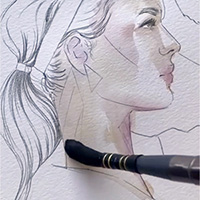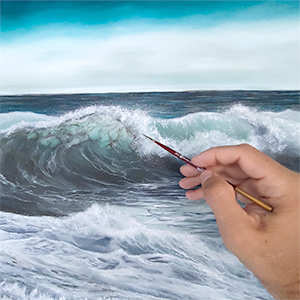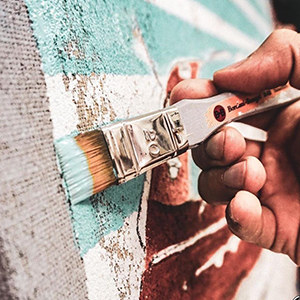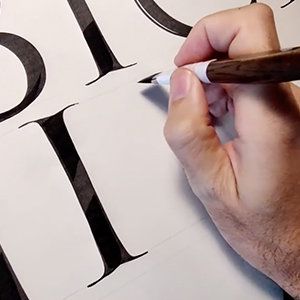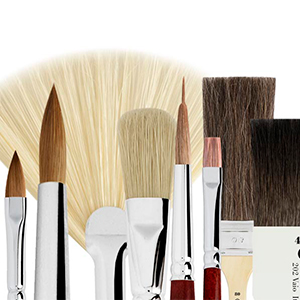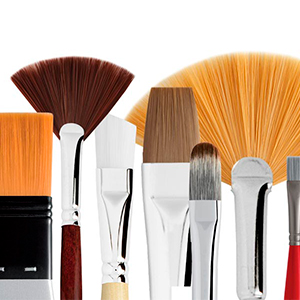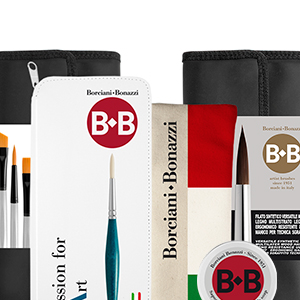Three things to know to start watercolor painting
Three things to know to start watercolor painting
Lightness, transparency and brilliance are the first things that our eye perceives in a watercolor painting.
The color that is dispersed in a thousand shades, the ability to capture light and the moment make the watercolor technique one of the most used by artists around the world.
The advantages of painting with watercolor are in its immediacy, and the fact that it doesn’t require the use of specific mediums, as for example with oil painting, with a minimum equipment you can practice anywhere, even on the road, allowing beginners to start painting right away with appreciable results.
To paint with watercolors you need few tools: watercolor brushes, paper, watercolor and water are the narrow - but more than enough - necessary to be able to paint freely.
Yet this technique, which may seem easy to an inexperienced eye, is actually quite complex. The use of the most suitable tools, the speed of execution and a good knowledge of color theory are essential to be able to have a good result for those who start painting with watercolor.
It should be remembered that the transparency, typical of the watercolor technique, does not allow correction of any errors through the overlapping of layers of color (as is the case in oil or tempera painting) because the drafts cannot in any way be hidden.
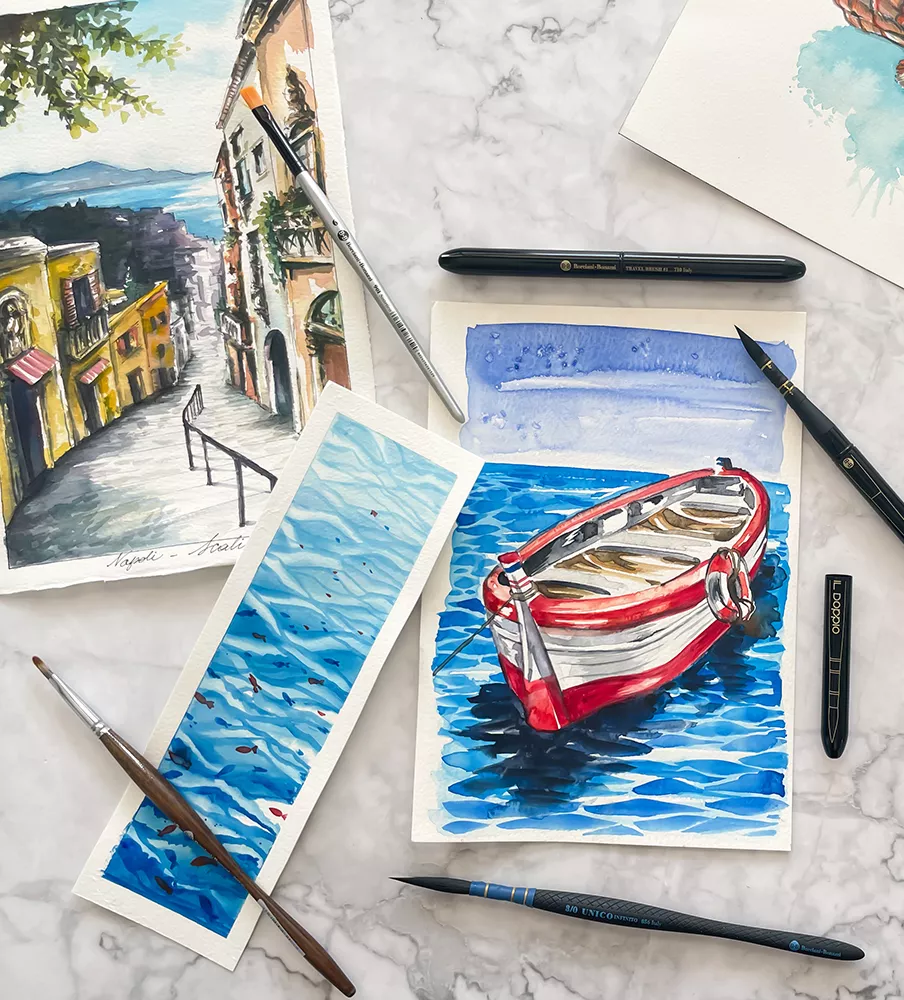
Watercolor painting: the historical notes
The first evidence of the use of watercolors as decorative tools dates back to 1300 BC, by the Ancient Egyptians.
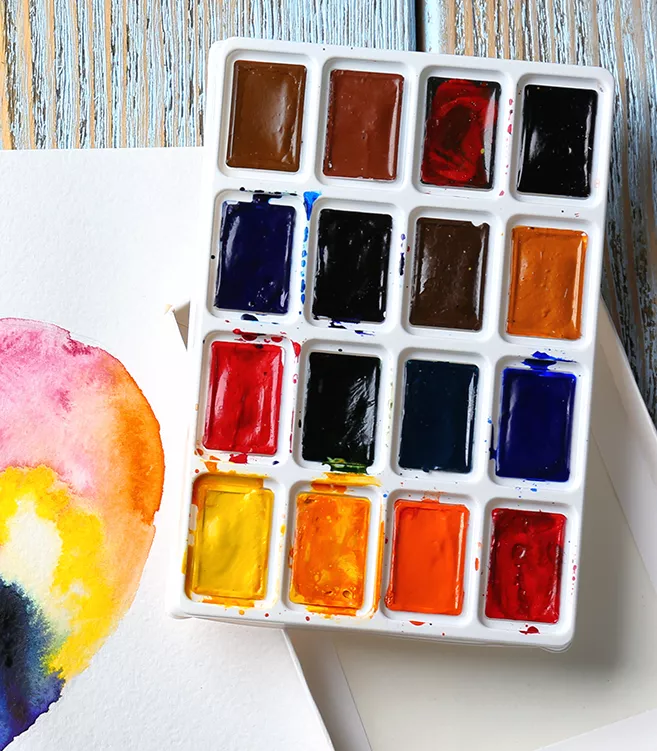
The first evidence of the use of watercolors as decorative tools dates back to 1300 BC, the time of the ancient Egyptians who used these colors for the illustration of some texts, among which the famous Book of the Dead stands out.
In ancient Greece, Rome, Byzantium and all the most famous civilizations of the past there is evidence of the use of the watercolor technique, mostly used for the decoration of miniatures, although it does not become part of the pictorial techniques of artists in the strict sense, being bound for a long time to the topographical sector and to illustration for educational purposes.
The diffusion of the watercolor technique grows exponentially with the spread of the press. The printed illustrations are in fact colored manually and the watercolor technique, thanks to its delicate brilliance and transparency, is crowned as the most appropriate choice.
It was not until the 13th and 19th centuries that watercolours were introduced to the great artists of the time. In these years the aesthetic tastes of the visual arts change and the brightest representations and the subjects with a landscape and naturalistic theme acquire acclaim, which lend themselves wonderfully to being represented with this technique. In 1804, in England, the first watercolor society in the world was founded, the Society of Watercolor Painters, which received the title of "Royal" at the hands of Queen Victoria in 1881.
And England, despite the harsh climate, is elected as the first spokesperson of this technique with the artists of the time, giving rise to the first industrial production of watercolor colors.
There will be a great diffusion with the travels in Europe of great painters and poets, of the XIX: predecessors of the modern Urban Scketch, armed only with a notebook, brushes and colours, created Grand Tours with figurative representations of the city, flora and fauna with photographic value.
Painting with watercolor: how watercolor painting is composed
To understand how to paint with watercolor at best is interesting to understand how watercolor are composed.
Watercolor paints are composed of two different substances that are carefully mixed together:
- • The real colors, the pigments, of organic and inorganic origin, are ground very finely to have the maximum dispersion in water
- • The binder, generally natural gum Arabic, which allows a dilution in water up to 90% while maintaining the cohesion between its particles.
The mixture of these two elements, in different percentages depending on the type of pigment used, creates the watercolor: full, dense and creamy, sometimes visually similar to black, which will appear in its bright shade only after being diluted with water.
The key feature of this mix is that it is eternally reversible in water, that is, it can dissolve, dilute and use to paint watercolor even after years of inactivity!
The formats in which the watercolor is presented are many: there are in fact the classic godet, the half godet, the tubes as well as watercolors in the liquid state, designed to be used by airbrush or used for large fields.
The godet and the mezzo godet are small rectangles containers in which the color is poured and then dried in the air, creating reserves that can be used to paint with watercolor for a long time.
Required step for beginners and for use in small format, to have more margin of error and greater controllability, the godet must always be "softened" with the help of brush and water.
Tube watercolors are recommended for more expert use: maintaining the creamy shape of the binder and pigment mix, they must be "kneaded" with a brush and water in the right quantities, to avoid leaving indelible traces on the support and be almost opaque. Ideal for painting with watercolor extensive backgrounds and for teachers of courses with more people should still be worked more to have the maximum yield.
The artists of the most impressionistic watercolor technique, who seize the moment, are used to carry a spray full of water to moisten both the colors and the paper, to avoid losing precious minutes to the realization of the work.
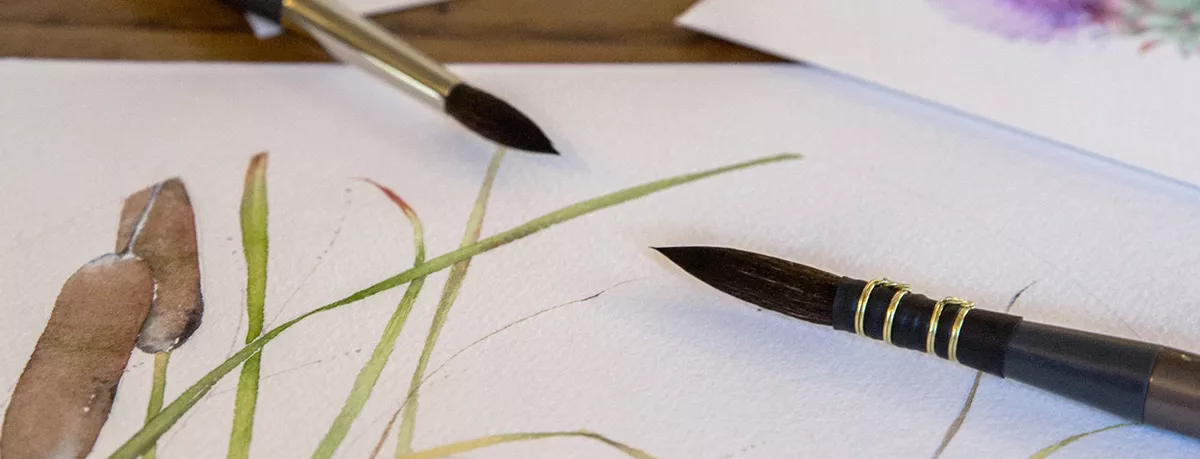
Painting with watercolor: the best supports
The supports for painting with watercolors can be of various nature but the ideal for the absorption of water and color are paper, parchment and cardboard.
After seeing the color composition, fundamental for such a particular technique is to know and use the most suitable tools that allow you to have the best result.
Painting with watercolor on paper
The paper most commonly used for watercolor painting consists of a paste of linen or cotton rags that guarantees an ideal roughness that allows the color to easily retain in the fibers. The drying of the fibers is slow and allows longer processing and dispersions that create delicate and transparent shades.
Pulp paper has excellent absorbency with faster drying, especially outdoors. Ideal for beginners and for small sizes, it allows layered and fast processing.
Often you create paper with mixed mixtures of cotton and cellulose, to optimize the result and drying speed.
All watercolor papers must have an acid free side, that is, they do not have the coated finish on the surface, to allow the color to be completely absorbed.
Fundamental in the choice of paper to paint with watercolors is the grammage: it must be thick enough to absorb water and color without creating unpleasant ripples and to be able to properly manage the absorption of water; from 300 grams onwards you will have the ideal paper for the watercolor technique.
You can buy paper in albums or blocks or in single sheets.
The watercolor painting paper album allows you to have many more sheets in a compact and practical format for transport. Fixed on the 4 sides with a passage of glue on the side edge allows you to work without fixing the paper on a rigid base and to use the "open" side to absorbency without making mistakes. You can also choose to use a slightly lower weight of paper (but not below 200 gr!) without undulations and saving a little.
Watercolor paint sheets are usually sold in larger sizes (one side can measure up to a meter) and are sold individually. They are designed to make larger works must be fixed on a rigid support with low adhesive tape.
Do not forget what grain you prefer for albums and sheets to paint with watercolor. Fine grain or coarse grain?
The finishing or grain of the paper, both cotton and cellulose, gives completely different characteristics to the watercolor painting: the choice is left to the artist according to the final effect he wants to achieve.
A very fine watermark paper will be adequate for a work that has a large number of details. Satin and fine are also ideal for those who start with the watercolor technique and want more control over the final effect of the brush stroke.
A rougher paper favors the deposit of color in more vigorous and intense brushstrokes. Rough or even hammered, the paper will give a more material look to the painting, with less control over the brush trace.
The base color of the watercolor papers is fundamental for the color rendering; the transparency of the watercolors is modulated on the bottom. The paper has many variations of white that go from optical white to hot butter color, and this is also chosen by the artist based on the result you want to achieve. The whiter the paper is, the more the colors will be very bright and slightly cold, while for a softer effect you can use a milk-colored paper.
Painting with watercolor on wood and cardboard
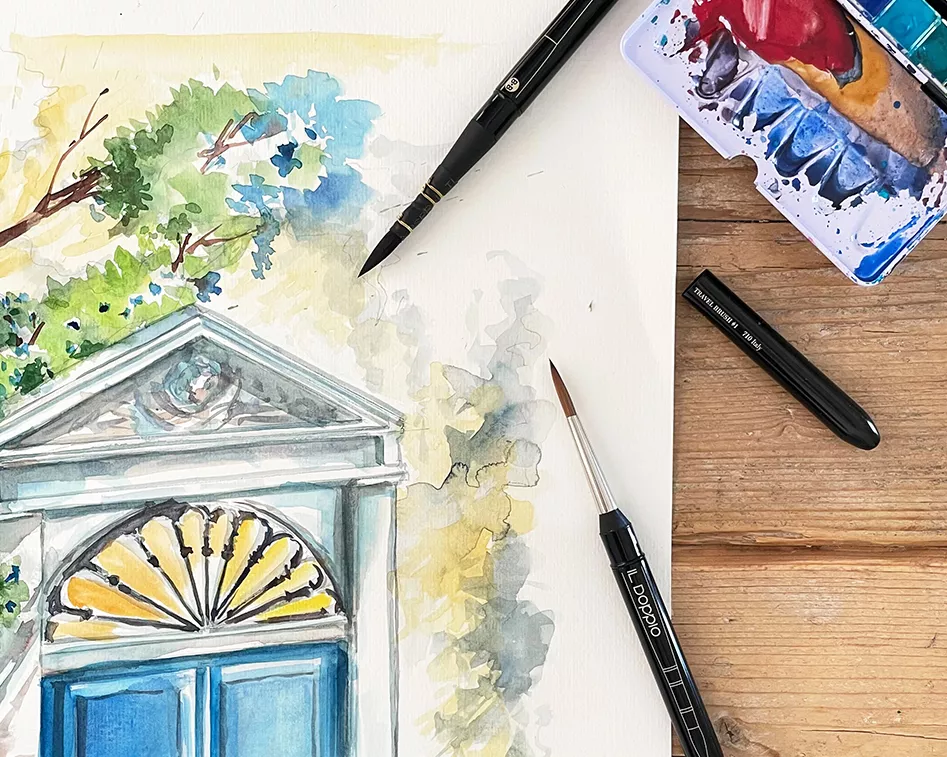
Natural wood absorbs a lot and many artists use the watercolor technique to reveal the grain. The same principle of painting wood with anilines uses this procedure. The texture of the wood will affect the absorbency of the color, making it difficult to realize details.
You can prepare to paint with watercolor wood with special acrylic mortars or stuccoes, obtained from mixtures of marble powders, glass microcapsules and acrylic resins.
These mortars, once dry, can be painted with watercolor with excellent results. Absorption will be rapid, but slow drying will be maintained on the surface, to be able to work in an appropriate time.
The vegetable board, with weights ranging from 200 to 900 grams is great for sketches, layouts and drafts. The color of the mixture is greyish and therefore for a good brightness of the painting you will have to prepare the base with a coat of white acrylic tempera diluted: the absorbency will be less and the drying will be slower.
Brushes for watercolor painting
What brushes should I use to paint with watercolor?
Watercolor brushes are essential for the success of a painting with this wonderful technique. Synthetic or Natural, must have in common the slow release of water and color on the support, without running the risk of dropping unwanted drops that would "eat" the underlying color!
Soft and light, to avoid scratching wet paper, or more elastic and reactive, whether they are natural or synthetic, the choice between the various fibers suitable for painting with watercolor is always based on the result desired by the artist, that modulates the different stylistic effects through the amount of water that is stored in the brush.
The greater the water contained in the fibers and the more the color will appear transparent and soft, while for details and small backgrounds you can use elastic watercolor brushes that release little color.
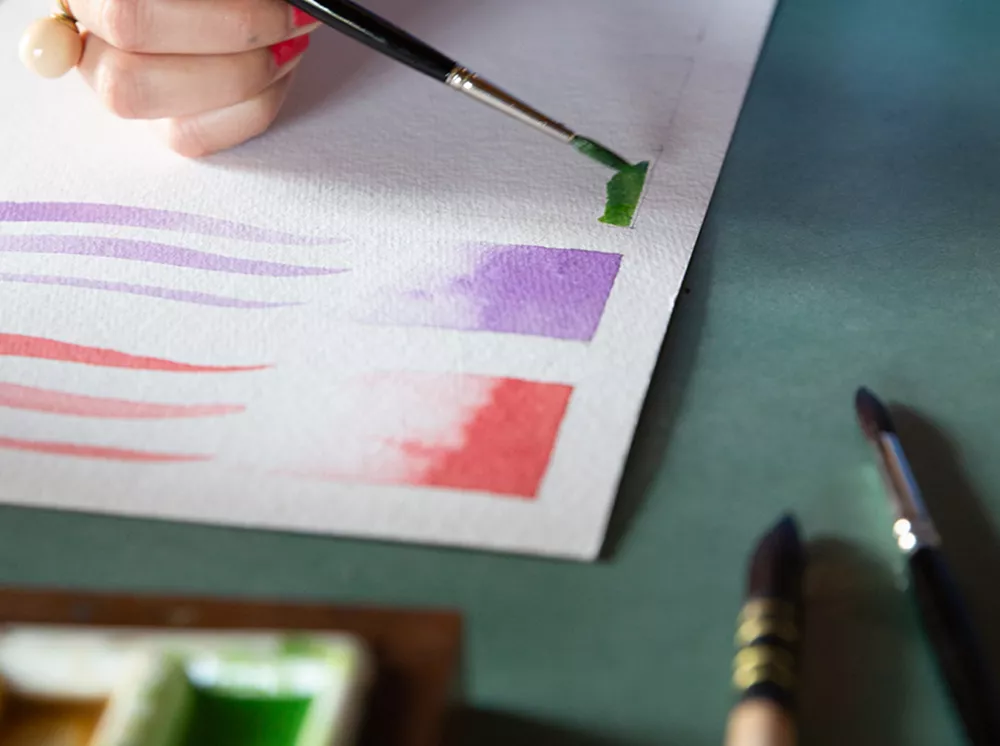
Natural brushes for watercolor painting
Tradition has it that to caress the paper with the watercolor you prefer the brushes in natural fiber, with slow release of water and maximum absorbency, and to clarify any doubt about the choice based on the characteristics we will make a detailed list:
Vaio Brushes

The brushes in vaio, natural squirrel hair, are characterized by extreme softness and high hygroscopicity.
This particular type of squirrel is born in Canada and in Russia, and the most valuable takes its name from the Kazan region, and has brown red reflections.
The exemplary softness of the brushes in vaio hair, the slowness of the release of color make it a necessary tool for the overlapping glazes of botanical watercolourists and for professionals in ceramics and porcelain.
Il tratto è lungo, morbido e controllato anche sulle superfici più lisce e rende il lavoro soffice ed arioso. Ideale con tecniche diluite, che siano ad acqua o olio, rimane uno dei pochi peli naturali ancora montato sulle penne d’oca.
Vaio brush codes for painting with watercolors: #69/C- #69/M- #69/L- #107/V- #168- #201- #202
Sable Brushes

The brushes in sable, in natural fur of animal Marten of the Musteridae family, which lives mainly in forest areas.
Widespread in almost all the north, it is divided into various species depending on the origin. Its precious fur, with characteristics of elasticity and very high absorbency, is used for various techniques, from watercolor to oil painting.
The regions of Asia and Northeastern Russia host the Kolinsky Sable, which growing in a cold and very humid climate has a softer and more resistant hair, while the Red Marten, slightly less valuable because it is diffused in all the forests of Northern Europe and Asia and in greater number, it has a little stiffer hair than the Siberian cousin.
Sable brushes are used by artists and also by dental studios, for the flexibility and precision of the stroke and the wide range of painting techniques used
Sable brush codes for painting with watercolors: #100 #101 #102 #102/C #105 #106 #107 #111 #112 #113 #114 #115 #204
Ox Brushes

The brushes in ox hair, in natural fur of Ox are perhaps the most used brushes ever
Characterized by an extreme softness and good release of water and absorbency color; ideal for low elasticity and fine hair to watercolor painting, acrylic, gouache and oil. The brush stroke is soft and light, the track is delicate and used especially for veils and shades.
The wide availability of the material, the economy and the resistance to wear make them perfect for those who approach for the first time the technique of watercolor as other painting techniques.
They are the brushes of tradition, and they can release both water and medium slowly to allow the painting to be made.
Ox hair brush for painting with watercolors: #70 #71 #71/C #72 #72/c #75 #76 #77 #78 #79 #205
Synthetic brushes for watercolor painting
The evolution of technology and research on environmentally sustainable materials has meant that the latest generation of synthetic fibers have nothing to envy to the natural fibers that have always been used for the realization of watercolor brushes. Performance of the highest level, constant and guaranteed quality standards, as well as an affordable price for everyone. together with the conscious choice of the artist have led synthetic fibers to be the favorite ones of our days.
Very different from each other for basic processing and final pictorial rendering, the synthetic fiber watercolor brushes have different characteristics that are chosen by the artist for the realization of the painting: soft and extremely absorbent, elastic while remaining light, or flexible and reactive for the definition plans, the synthetic fibers are born from the imitation of the natural hair to improve the best characteristics.
From the artist to the student in synthetic fibers we can choose for the watercolor technique a huge variety of brushes, based on elasticity, water release and trace of the brush stroke.
Also useful is the choice of the handle, short or long, according to your needs: greater ease for a table or travel watercolor painting you will have with short handles, while for large sizes the long handle will help in a more correct overview. Let’s see what are the substantial characteristics and for what uses they are ideal.
Students, beginners, but also Illustrators and watercolor painters who want to make perfect details in small sizes will prefer more elastic fibers and less absorbency for greater control of the release of water and color such as Synthetic Gold Fibre, the Synthetic Green Fibre, the Single Flamed Fibre and for a precise and well-defined stretch the Synthetic dark red violet fibre and the Synthetic Unico Silver one.
For those who prefer a wider absorbency of water, also works on large sizes and wants a longer processing time the choice is between hollow and hygroscopic fibers, soft and elastic at the same time, ideal for working wet on wet without scratching the paper such as Mongoose fiber, Hidro fiber and Kolinsky synthetic fiber MKS®.
Synthetic Mongoose

The technological research of Borciani and Bonazzi has sought and found a valid synthetic alternative to the natural hair of the Mongoose: animal native to South East Asia and Africa, whose precious hair, extremely thin and hygroscopic has been collected for centuries to create fine brushes from the slow release of water.
The risk of extinction and the exclusively wild nature of these animals have led to the search for a valid synthetic fibre replacement.
The yarn of the synthetic Mongoose brush is characterized by a high conicity, wide at the base and thin at the tip, exceptional softness and absorbency with slow release of water.
It is a light and soft fiber, hollow inside and therefore ideal for very diluted techniques, such as watercolor, and also for fluid acrylic and oil in glazes. It perfectly replaces the softest animal fibers, with an affordable cost for everyone.
Ideal for those who start their journey in the technique of watercolor with the best tools.
Mongoose Synthetic brush codes for watercolor painting: #800 #801 #802
HIDRO

Patented synthetic HIDRO® fiber Borciani e Bonazzi, born with the use of advanced nanotechnology and characterized by an exceptional absorbency, combines a slow and constant release of water to the elastic return of the tip shape.
The fibers are micro-perforated and soft, and maintain excellent elasticity for mixtures born from the processing in conical and corrugated section.
Ideal for watercolor due to the exceptional water flow rate and the high absorbency in the washings, it is an excellent help for all light and diluted techniques, from the thinnest oil to ceramic painting.
It is used in the last lines of brushes of Unico Infinito in all its variants.
HIDRO® brush codes for watercolor painting: #850 #855 #856 #751
Kolinsky Synthetic Sable

The acronym MKS® of the new synthetic fiber of Borciani and Bonazzi indicating Kolinsky Synthetic Sable: this highly technological fiber replicates the performance of the natural sable hair, with a greater sustainability of brushes.
The MKS synthetic fiber is treated with processes that give the characteristic elasticity and softness, creating microporosity on the basic structure that mimic the roughness of the natural hair of the Sable.
This significantly slows down the release of water and media, and the taper of the fibers allows medium-thick processing and shape return for high precision in details.
The Kolinsky Synthetic Sable is ideal for both highly diluted techniques such as watercolor, glazing and inking, and for more pasty techniques such as oil, acrylic and gouache, making it a transverse fiber on the most varied artistic applications.
MKS brush codes for watercolor painting: #620 #621 #622 #623 #624 #625 #626 #107/S
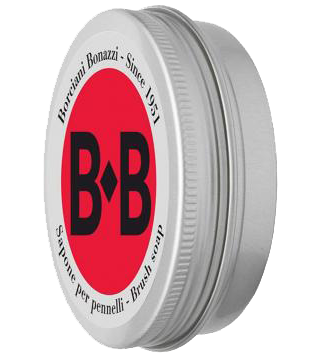
Watercolor Brushes Cleaning
For a correct maintenance and a longer duration in time, at the end of each session, the brushes should be washed with care, using special neutral detergents, such as Borciani e Bonazzi Vegetable Soap; rich in vegetable oils, moisturizes both natural hair and synthetic fibers while maintaining the tip and trace of the brush over time, carefully removing the residue of color.
Even in the case of watercolor painting, where the color is very diluted, the tenacity of some organic pigments tends to remain between the fibers, especially if hollow or micro-perforated: very useful will be the use of the silicone pad with rounded ridges, to create a pressure on the fibers without ruining them and removing all the color.
The ideal drying is upside down suspended in the brush holder, for a discharge helped by gravity.
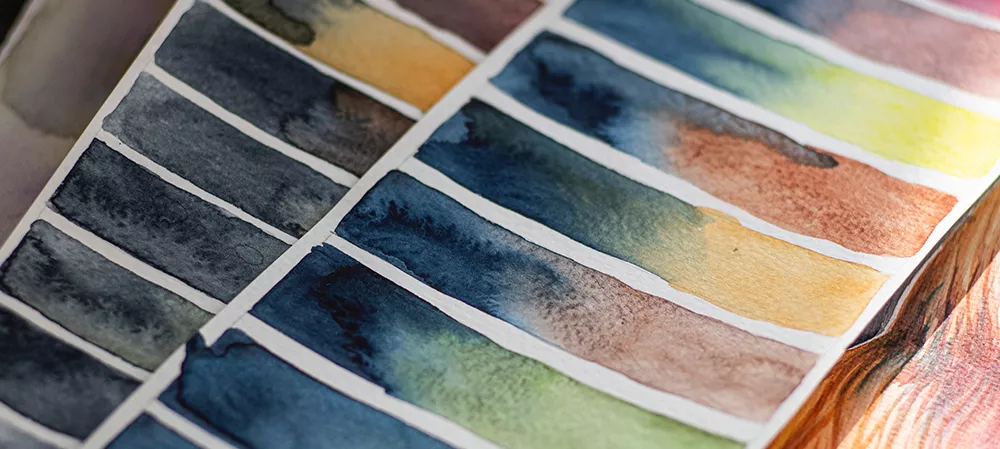
3 Things To Know About Watercolor Painting
There are many and many works that can be realized in watercolor, from the botany made of light veils superimposed on the impressionist technique that works mainly on paper still wet illustration and urban schetcking that mix different interventions.
As there are many teaching methods, so we will only make a trace that avoids the most gross mistakes: it is always constructive to start learning a painting technique with a good course, which will simplify the basic steps. Then practice and exercise will do the rest!
1. Start with basic drawing
Starting from the bases, the drawing must be executed with a stroke just mentioned, to avoid that the marks shine through pencil or charcoal through the color; pencils will therefore be preferred well pointed with graphite of medium softness, to prevent the release of darkening particles in water and colour.
The pencils HB and F are among the most used, but this also depends on the intervention that the artist wants to do.
Watersoluble pencils and graphites shall be avoided to avoid losing the mark traced with the dilution, unless the drawn base is to be completely erased.
Any corrections to the drawing may also compromise the outcome of the painting. The eraser leaves on the paper inevitable abrasions that adversely affect the homogeneity of pigment absorption. Bread gum is generally used, a moldable soft rubber that retains excess graphite on the paper surface.
2. Prepare the paper thoroughly
To prepare the watercolor paper for homogeneous color absorption, it is first fixed on a rigid support, also in vegetable cardboard, with low-adhesion adhesive tape.
The second step is the "wash", obtained by applying on the whole well-stretched surface of the paper plenty of water with soft fiber brushes: this will remove residues that could make the color absorb differently (and we would notice it only in completely dry color!) Few know that even just the fingerprint, no matter how clean the hands are, leaves on acid free watercolor paper a trace in which the color absorbs less!
The fundamental thing to keep in mind in the watercolor technique is that the color is very transparent; it will always start from the lighter color, and more diluted, to go to "saturate" later with more intense color.
White is rarely used to create shades, it is the dilution with water that creates the lightest and most transparent color, so the light of the painting is created leaving parts of paper dry and without color.
In this regard, a very useful accessory to trace parts that remain perfectly white is the Liquid Latex or Liquid Masking.
With a brush properly passed in the vegetable soap, to avoid ruining it, the latex is spread in the defined areas, and drying in the air becomes a rubber perfectly adherent to the surface that does not let the color pass. It will be removed with a soft cloth only after complete drying of the painting with a slight rubbing movement.
3. Learn the main basic techniques
There are three main techniques of colour application: wet on wet, commonly called wet on wet, wet on dry and overlapping glazing.
- WET ON WET: The wet on wet method is done by spreading the color directly on a wet sheet, which allows the pigment to spread easily. Used mainly for the coloring of the funds, it is very useful also to create the first volumes in the painted shapes, leaving the parts in light almost devoid of color. It is also the first technique you learn when you start painting: the shades are soft and delicate and even a beginner is able to make them, letting the water work on the paper.
- DRY ON WET: Contrary to wet on wet, the wet on dry method is characterized by the spread of color, dissolved in water, directly on a previously made and dry color or on neutral paper. Widely used in illustration and for small detailed backgrounds, it creates a greater definition of strokes and full backgrounds. The stroke mark is clean and must be safe and precise.
- OVERLAPPING GLAZES: In this method, the color spots overlap as you proceed in the laying, in order to give the painting greater depth. Made on dry field in botany and hyperrealism, allows you to get almost photographic effects. If the underlying background is still wet, the stretch will be less defined and with the risk of going to "wash" the previous draft.


